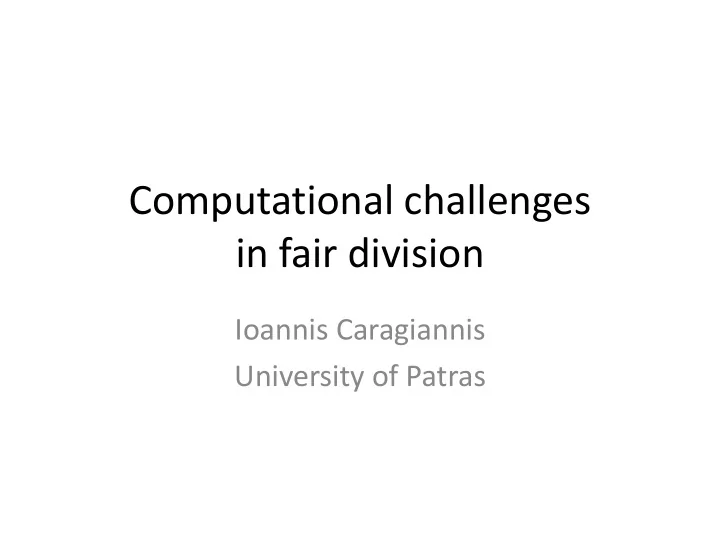

Computational challenges in fair division Ioannis Caragiannis University of Patras
The general problem • Input: – A collection of items – Users (or agents) that have utilities for bundles of items • Goal: – Allocate the items to the agents so that the allocation is fair according to specific fairness criteria • Variations: – Divisible vs indivisible items, restricted utility functions, different notions of fairness • Many applications: e.g., ICT, multi-agent systems, negotiations, peace treaties, etc.
Example: Alice and Bob get divorced items 1 5 1 3 Alice 4 3 1 2 Bob Utilities
Example: Alice and Bob get divorced items 1 5 1 3 Alice 4 3 1 2 Bob An envy-free allocation
Example: Alice and Bob get divorced items 1 5 1 3 Alice 4 3 1 2 Bob An equitable allocation
Fairness criteria • Proportionality: each user feels she got a fair share • Envy-freeness: no user envies the bundle of any other user • Equitability: all users are equally happy • Max-min fairness: the least happy user is as happy as possible
Other criteria • Efficiency of allocations – Pareto efficiency – Social welfare • Efficiency of computation – Fast computation (e.g., polynomial-time) – Preferably in a distributed way • Resistance to manipulability – Strategy-proofness
Example: envy-free cake cutting • Input: – A divisible item (cake) – Two agents, each having private utilities over parts of the cake • Goal: – Allocate pieces of the cake to the agents so that nobody envies the part allocated to the other player • Good news: – We know how to solve the problem for 2 and 3 agents
Many related issues • What is the computational complexity of the problem? – Looks like searching for a needle in a haystack • Provable lower bounds? – All we know is that envy-freeness is slightly more difficult to achieve than proportionality • Restricted utilities • More expressive models – E.g., restriction for contiguous pieces – E.g., no utility for trimmings • What about other fairness criteria? – E.g., approximate equitability
Another example: the Santa Claus problem • Input: – Santa Claus has a bag full with toys – Several kids, each having a utility for each toy • Goal: – Compute an allocation so that the utility of the least happy kid is maximized • Good news: – We know how to compute O(logn)- approximate allocations
Related challenges • Improved approximation algorithms • Inapproximability results • Restricted utilities • Other fairness objectives with indivisible items • More expressive models
Many more issues • Tradeoffs between fairness and efficiency – E.g., fairness and Pareto-efficiency • What is the price of fairness? – How suboptimal can the social welfare be in a fair (proportional, envy-free, equitable, max-min fair) allocation? • Strategy-proofness – Incompatible with fairness (in general) – Monetary incentives, transferable utilities
Recommend
More recommend